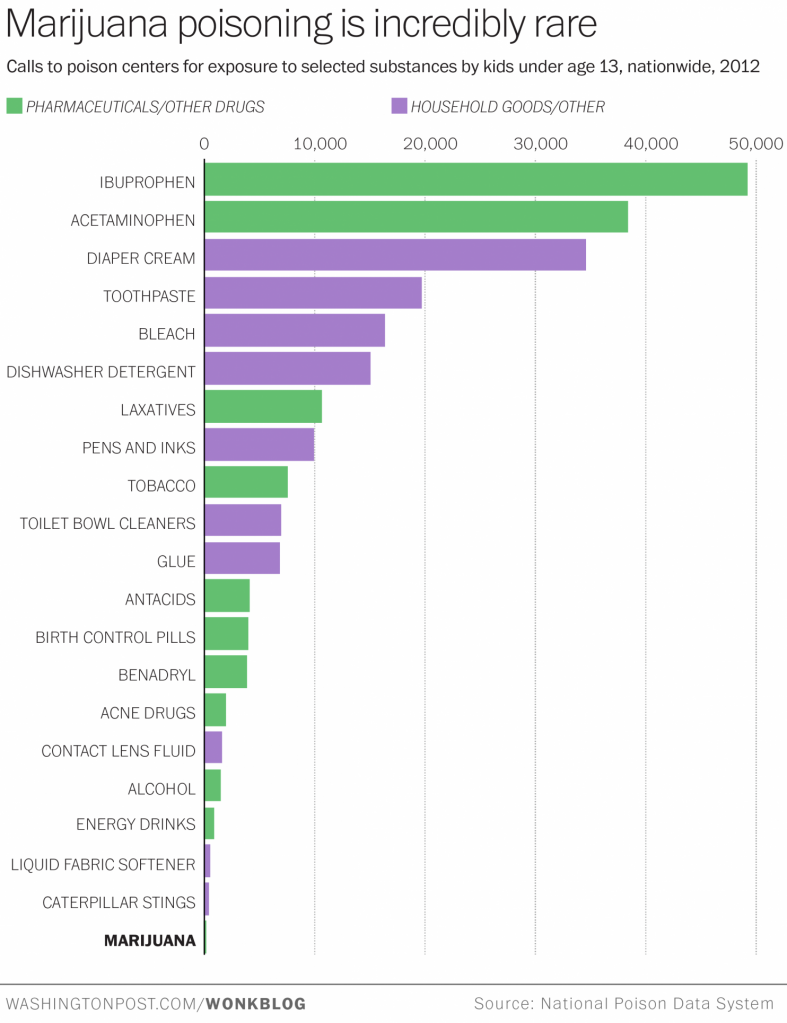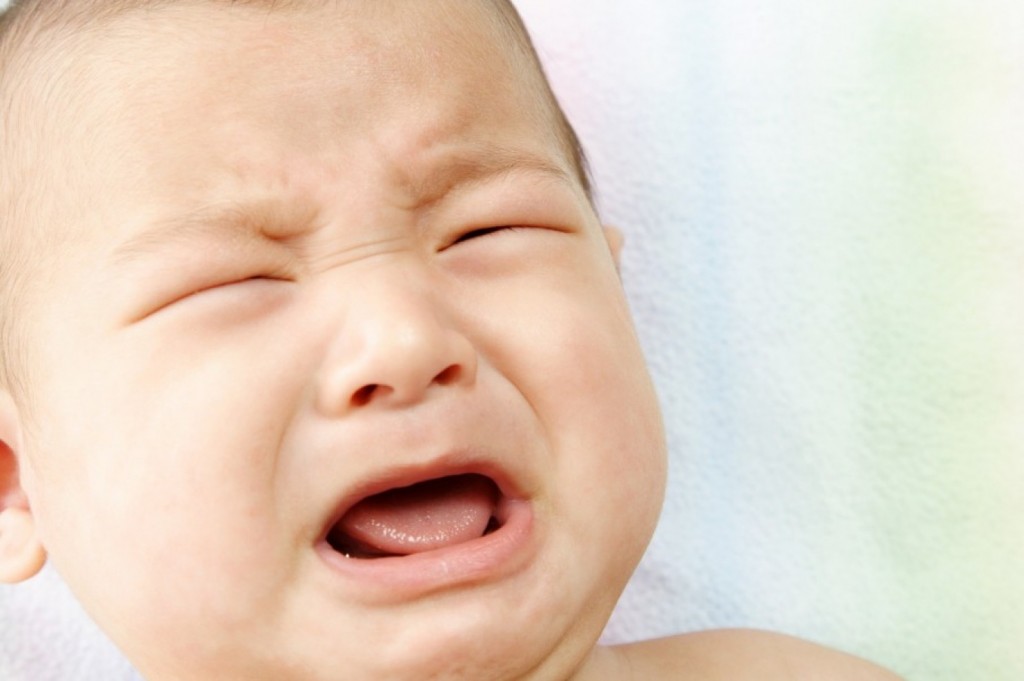The most politically potent arguments against marijuana legalization have focused on the effects of looser marijuana laws on teens and children. Opponents say that legalization will lead to increased use among teens (so far it hasn't), and recite the drug war mantra that it will "send the wrong message" (if so, it appears that kids aren't listening).
Colorado's market for edible marijuana products, pot-infused baked goods, candies, beverages and the like, has been a particular area of concern. The accidental ingestion of edibles by kids has received a huge amount of media attention. One widely-reported study found that the number of kids under 12 who were admitted to the E.R. for accidental pot ingestion in Colorado jumped from zero to 14 after the state liberalized medical marijuana laws in October 2009. More recently, the Denver Post reported on a "surge in kids" accidentally eating pot from 2013 to 2014.
Stories like these are a big part of the push for tougher packaging requirements on Colorado's edibles, the Associated Press's Kristen Wyatt reported this weekend. The Colorado Health Department is planning to recommend that new edible projects are subject to "pre-market approval" by a new commission. Previously, the department had recommended a total ban on the sale of edible products, only to hastily withdraw the proposal shortly after it was made public.
According to the AP, the department wrote that it "remains concerned that there are products on the market that so closely resemble children's candy that it can entice children to experiment with marijuana." These concerns are understandable, but they're blown far out of proportion to the actual numbers.
Marijuana baked goods have been around for nearly as long as marijuana. And marijuana candy has been around for well over a decade, at least. And regardless of the delivery method - whether via edibles or smokes - cases of children being unintentionally exposed to marijuana are vanishingly rare.
Let's zoom out to the national picture to take a look. The American Association of Poison Control Centers maintains the National Poison Data System, a near-realtime database of literally every call made to a poison control center in the U.S. Their most recent annual report, reflecting data from 2012, allows us to see the number of reported poisoning cases for marijuana, and to compare this to other common drugs and household substances, including over the counter painkillers, diaper creams, and contact lens fluid. I've charted a handful of these below.

What you can see is that for kids 12-and-under, cases of marijuana poisoning are incredibly rare. There were 254 such calls in 2012. By contrast, there were about 1,000 calls related to kids ingesting energy drinks, 1,600 for kids drinking contact lens fluid, and over 4,000 for children who ate birth control pills.
Calls for caterpillar stings were twice as common as calls for marijuana exposure, and ingestions of liquid fabric softener were nearly three times as common.
Thirty-five thousand concerned parents called poison control when their offspring ate diaper creams, nearly 40,000 calls were for ingestion of acetaminophen, and 50,000 were related solely to kids eating too much ibuprofen. Across all substances, the vast majority of cases were for kids 5 and under.
These numbers don't tell us about the disposition of these calls - that is, whether parents were told to bring their kids to the hospital, or to just take it easy and put the diaper cream on a higher shelf in the future. They also shouldn't be construed to mean that pot is safer for your kids than say, ibuprofen or diaper cream. As a parent of one-year-old twins, I would be much more worried if my kids ate a pot cookie than if they snuck a dab of toothpaste when nobody was looking.
The numbers are partly a function of the fact that ibuprofen and diaper cream are much more common than marijuana in households with small kids. But they suggest that parents who do smoke weed are, generally, doing a pretty good job of keeping it out of kids' reach.
Even drilling down to the Colorado numbers, let's recall that the most widely-cited study unearthed a grand total of 14 kids going to the E.R. for accidental marijuana ingestion between October 2009 and December 2011. That represents about 2.4 percent all ingestion-related E.R. visits for that age group over that period. While nobody wants to see a kid go to the hospital, every single one of the 14 was sent home, and "none of these exposures resulted in permanent morbidity or mortality," according to the study.
These numbers are almost certain to inch up as Colorado's marijuana market matures. Frankly they have nowhere to go but up, as they are almost literally at rock-bottom now. Legalization opponents will continue to use them as fodder for their arguments, and as evidence of the need for tougher regulations. But it's important to keep them in perspective: nationwide, kids are 136 times more likely to be poisoned by their diaper cream than by pot, yet nobody is calling for stricter labeling requirements on Desitin.

News Moderator: Shandar @ 420 MAGAZINE ®
Source: Washington Post: Breaking News, World, US, DC News & Analysis
Author: Christopher Ingraham
Contact: https://www.washingtonpost.com/actmgmt/help/
Website: Your kid is 136 times more likely to be poisoned by diaper cream than by weed - The Washington Post
Colorado's market for edible marijuana products, pot-infused baked goods, candies, beverages and the like, has been a particular area of concern. The accidental ingestion of edibles by kids has received a huge amount of media attention. One widely-reported study found that the number of kids under 12 who were admitted to the E.R. for accidental pot ingestion in Colorado jumped from zero to 14 after the state liberalized medical marijuana laws in October 2009. More recently, the Denver Post reported on a "surge in kids" accidentally eating pot from 2013 to 2014.
Stories like these are a big part of the push for tougher packaging requirements on Colorado's edibles, the Associated Press's Kristen Wyatt reported this weekend. The Colorado Health Department is planning to recommend that new edible projects are subject to "pre-market approval" by a new commission. Previously, the department had recommended a total ban on the sale of edible products, only to hastily withdraw the proposal shortly after it was made public.
According to the AP, the department wrote that it "remains concerned that there are products on the market that so closely resemble children's candy that it can entice children to experiment with marijuana." These concerns are understandable, but they're blown far out of proportion to the actual numbers.
Marijuana baked goods have been around for nearly as long as marijuana. And marijuana candy has been around for well over a decade, at least. And regardless of the delivery method - whether via edibles or smokes - cases of children being unintentionally exposed to marijuana are vanishingly rare.
Let's zoom out to the national picture to take a look. The American Association of Poison Control Centers maintains the National Poison Data System, a near-realtime database of literally every call made to a poison control center in the U.S. Their most recent annual report, reflecting data from 2012, allows us to see the number of reported poisoning cases for marijuana, and to compare this to other common drugs and household substances, including over the counter painkillers, diaper creams, and contact lens fluid. I've charted a handful of these below.

What you can see is that for kids 12-and-under, cases of marijuana poisoning are incredibly rare. There were 254 such calls in 2012. By contrast, there were about 1,000 calls related to kids ingesting energy drinks, 1,600 for kids drinking contact lens fluid, and over 4,000 for children who ate birth control pills.
Calls for caterpillar stings were twice as common as calls for marijuana exposure, and ingestions of liquid fabric softener were nearly three times as common.
Thirty-five thousand concerned parents called poison control when their offspring ate diaper creams, nearly 40,000 calls were for ingestion of acetaminophen, and 50,000 were related solely to kids eating too much ibuprofen. Across all substances, the vast majority of cases were for kids 5 and under.
These numbers don't tell us about the disposition of these calls - that is, whether parents were told to bring their kids to the hospital, or to just take it easy and put the diaper cream on a higher shelf in the future. They also shouldn't be construed to mean that pot is safer for your kids than say, ibuprofen or diaper cream. As a parent of one-year-old twins, I would be much more worried if my kids ate a pot cookie than if they snuck a dab of toothpaste when nobody was looking.
The numbers are partly a function of the fact that ibuprofen and diaper cream are much more common than marijuana in households with small kids. But they suggest that parents who do smoke weed are, generally, doing a pretty good job of keeping it out of kids' reach.
Even drilling down to the Colorado numbers, let's recall that the most widely-cited study unearthed a grand total of 14 kids going to the E.R. for accidental marijuana ingestion between October 2009 and December 2011. That represents about 2.4 percent all ingestion-related E.R. visits for that age group over that period. While nobody wants to see a kid go to the hospital, every single one of the 14 was sent home, and "none of these exposures resulted in permanent morbidity or mortality," according to the study.
These numbers are almost certain to inch up as Colorado's marijuana market matures. Frankly they have nowhere to go but up, as they are almost literally at rock-bottom now. Legalization opponents will continue to use them as fodder for their arguments, and as evidence of the need for tougher regulations. But it's important to keep them in perspective: nationwide, kids are 136 times more likely to be poisoned by their diaper cream than by pot, yet nobody is calling for stricter labeling requirements on Desitin.

News Moderator: Shandar @ 420 MAGAZINE ®
Source: Washington Post: Breaking News, World, US, DC News & Analysis
Author: Christopher Ingraham
Contact: https://www.washingtonpost.com/actmgmt/help/
Website: Your kid is 136 times more likely to be poisoned by diaper cream than by weed - The Washington Post






